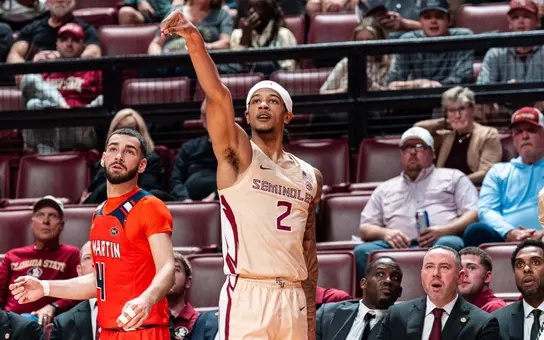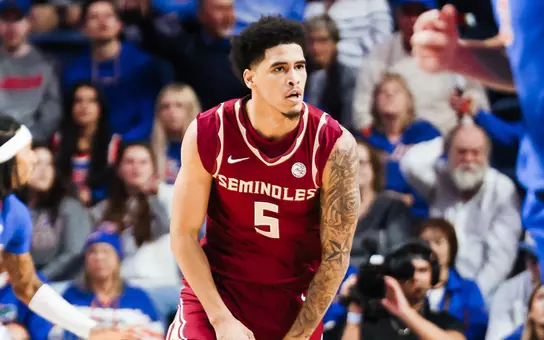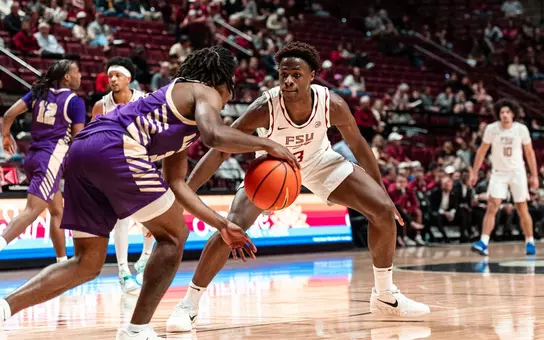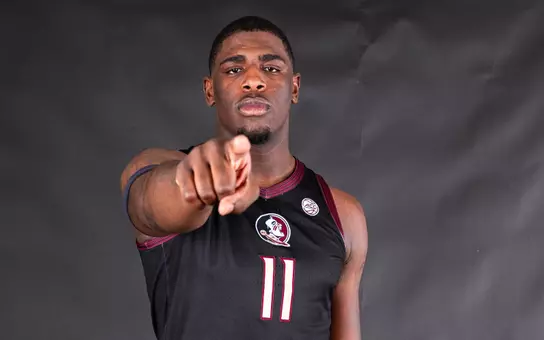Florida State University Athletics
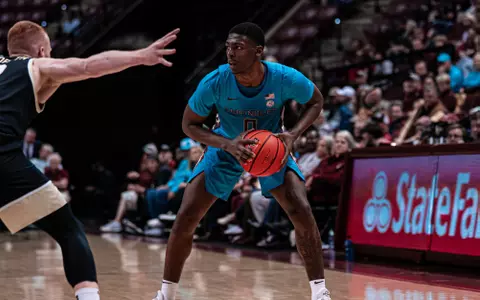
Florida State Honors Seminole Heritage Against Hofstra Tuesday At 7 PM
11/18/2024 3:10:00 PM | Men's Basketball
TALLAHASSEE – Florida State (3-1) plays host to Hofstra (4-0) on Tuesday, November 19, 2024 at 7:00 p.m. at the Donald L. Tucker and honors its Seminole Heritage as the team wears its unique turquoise uniforms against the Pride. It marks the 29th time the Seminoles will wear the uniforms since first wearing them on November 17, 2013, in an 89-61 win over UT Martin. It's the first time the Seminole have worn the uniforms against Hofstra. Florida State most recently wore the turquoise unforms at Virginia Tech on February 24, 2024 in Blacksburg. The Seminoles are 20-8 when wearing the special Heritage turquoise uniforms.
The color Turquoise represents harmony, friendship and fellowship throughout Native American communities and is used in tribute to Florida State University's special friendship with the Seminole Tribe of Florida.
Florida State Men's Basketball's iconic turquoise heritage jerseys pay homage not only to the Seminole Tribe, but to bringing sport to all Native American and Indigenous youth.
Florida State is one of a handful of schools that regularly wear Nike's turquoise Heritage basketball jerseys. Nike's Heritage Fund was created in 2009 to help create a place for sport in Native American and Indigenous communities, with the goal of healthier, happier and more successful lives.
The Seminole men's basketball program first wore the turquoise uniforms in 2013, and since that time the jerseys have been worn every single year as a way to honor the Seminole Tribe of Florida and our relationship.
The jerseys are always worn for a game in November as part of Native American Heritage Month. Florida State Men's Basketball often wears the Heritage jerseys when it plays at the Orange Bowl Classic in Sunrise, Fla. or in venues that are close to the six Florida Seminole Reservations in Big Cypress, Brighton, Hollywood, Immokalee, Tampa and Fort Pierce.
The national champion Florida State soccer debuted turquoise goalkeeper jerseys during their 5-1 win over Louisville on September 22, 2022.
Games that feature turquoise will now be known as "Seminole Heritage" games in recognition of our partnership with the Seminole Tribe of Florida.
The Seminole football staff wore turquoise gear on the sidelines during their homecoming matchup vs. Duke on October 21, 2023 and will wear the turquoise gear on Saturday, November 23, 2024 against Charlston Southern. While the football student-athletes will not wear turquoise jerseys on the field, turquoise fan jerseys will be available at select retailers, and a limited release of sideline gear mirroring what the football staff will wore during our Homecoming game will be available.
The availability of turquoise football jerseys and other sideline gear is a way fans can participate in and honor our long-standing relationship with the Seminole Tribe of Florida.
A portion of the proceeds from the sale of Seminole Heritage merchandise will go towards Florida State's Native American and Indigenous Studies Center to support programs for Indigenous youth at FSU and public education about the Seminole Tribe of Florida.
Key Moments
1947: Shortly after FSU became a coeducational institution, the student body voted to become known as the "Florida State Seminoles." It chose the name without the permission or participation of the Seminole Tribe of Florida. Today, as a sovereign tribe, the Seminole Tribe of Florida works closely with FSU to ensure that the use of the Seminole name and iconography are used with consistency to the Tribe's values.
1972: For the first time, the Seminole Tribe of Florida attended homecoming festivities as official representatives of the tribe. The delegation included Miss Florida Seminole, an official spokeswoman for the tribe, who has crowned the homecoming court at FSU ever since. The annual delegation has typically included elected Tribal officials (usually the chairman or chairwoman) as well as family members of Miss Florida Seminole and now Jr. Miss Florida Seminole. To this day, Seminole women make the turbans in the manner that has been used for many generations, and crown Florida State's Homecoming Chief and Princess.
1978: Bill Durham, a Tallahassee businessman and FSU alumnus, convinces football coach Bobby Bowden to support the creation of a new school tradition — a depiction of a Seminole warrior astride a horse — as a means of increasing school spirit at football games. After consultation with the Seminole Tribe of Florida and in particular with Chairman Howard Tommie, a horse owned by Tallahassee veterinarian Dr. Jerry DeLoney makes its first appearance as Renegade at an FSU football game on Sept. 16, 1978. The horse is ridden by FSU student Jack Kidder, who depicts an unnamed Seminole warrior.
1982: As a national debate over the use of Native American names and images continued, FSU officially began to examine its own behavior. When word of these conversations reached the public, Seminole Chairman James E. Billie insisted that only the sovereign Seminoles had the right to make this determination and declared that he would let FSU know if he or the Tribe was offended. This insistence on the sovereign right of the Seminoles to speak for themselves still shapes how FSU treats its use of the Seminole name.
2005: A new NCAA policy brought renewed national attention to the use of Native American names. The Seminole Tribe of Florida asserted the rights of the Seminoles to speak for themselves. In the end, the Tribal Council passed a resolution that supported FSU's continued use of the Seminole name and associated images. The resolution, in many ways, mirrored Billie's earlier insistence that the Seminoles have a sovereign right to speak on the issue. The resolution of the Tribal Council convinced the NCAA to allow Indigenous communities to sanction the use of their name, an exception that only a handful of universities enjoy.
2013: The men's basketball program first wore the turquoise uniforms in their 89-61 win over UT-Martin in Tallahassee on November 17, 2013, and since that time the jerseys have been worn every single year as a way to honor the University's relationship with the Seminole Tribe of Florida.
2014: New athletic uniforms debuted, which incorporated Seminole Patchwork, and the symbols man on horse, arrow, and fire.
2016: The Florida State student government passes a resolution which discourages fans from wearing Native American headdresses to Florida State athletic events. The Seminole Tribe of Florida traditionally wear turbans, and not headdresses.
2017: Justin Motlow made history as the first member of the Seminole Tribe of Florida to score a touchdown for Florida State University. The junior wide receiver caught a 12-yard pass during the game versus Delaware State to help lead his team to victory.
2020: As a member of the Crow Tribe and Greasy Mouth clan, Men's Basketball player RayQuan Evans suited up for the Seminoles for three winning seasons. He told The Athletic in 2020 how much the Heritage jerseys meant to him, saying "I haven't really been a part of a program that did that. I've never been a part of a program that really paid attention to it at all. To see that and to have the whole day where it was just the Heritage jerseys and everyone's wearing blue — I thought that was really cool. It was good to show respect. I loved it. It was amazing."
2022: Soccer debuted turquoise goalkeeper jerseys during their 5-1 win over Louisville on September 22, 2022.
OSCEOLA AND RENEGADE
Osceola is a towering figure in Seminole history—a leading warrior who opposed U.S. government efforts to force them from their Florida homelands in the 1830s. The Seminole's opposition to removal led many to call them runaways (Seminoles or cimarrons in Spanish) or renegades.
The creation of FSU's Osceola and Renegade tradition began when FSU supporter and alumnus, Bill Durham, pitched the idea to head football coach Bobby Bowden in the mid-1970s and was met with great enthusiasm.
Next, Durham met with Howard Tommie, then chairman of the Seminole Tribe of Florida, who did more than just sanction the tradition. Tommie arranged to have tribal members design the clothing worn by the FSU student depicting Osceola and created the parameters that control how and where Osceola and Renegade can appear today.
Today, FSU's Osceola is outfitted by members of the Seminole Tribe of Florida.
SEMINOLE PATCHWORK
The Seminole Tribe of Florida wears a unique form of patchwork clothing that is an integral part of their culture.
In the 1910s, Seminole women began to create clothing by sewing together horizontal strips of cloth with carefully sewn geometric designs. With the aid of sewing machines, these women resourcefully turned scraps of fabric into a distinctive form of artwork that is now commonly known as Seminole patchwork. Early patterns included blocks and bars of alternating color with occasional sawtooth designs that were sewn directly into garments. Over time, Seminoles embraced patchwork as a cherished tradition and the designs became more intricate.
FSU's pattern is used with permission from the Seminole Tribe of Florida, who call the three horizontal designs (from top to bottom) arrow, man on horse, and fire.
The color Turquoise represents harmony, friendship and fellowship throughout Native American communities and is used in tribute to Florida State University's special friendship with the Seminole Tribe of Florida.
Florida State Men's Basketball's iconic turquoise heritage jerseys pay homage not only to the Seminole Tribe, but to bringing sport to all Native American and Indigenous youth.
Florida State is one of a handful of schools that regularly wear Nike's turquoise Heritage basketball jerseys. Nike's Heritage Fund was created in 2009 to help create a place for sport in Native American and Indigenous communities, with the goal of healthier, happier and more successful lives.
The Seminole men's basketball program first wore the turquoise uniforms in 2013, and since that time the jerseys have been worn every single year as a way to honor the Seminole Tribe of Florida and our relationship.
The jerseys are always worn for a game in November as part of Native American Heritage Month. Florida State Men's Basketball often wears the Heritage jerseys when it plays at the Orange Bowl Classic in Sunrise, Fla. or in venues that are close to the six Florida Seminole Reservations in Big Cypress, Brighton, Hollywood, Immokalee, Tampa and Fort Pierce.
The national champion Florida State soccer debuted turquoise goalkeeper jerseys during their 5-1 win over Louisville on September 22, 2022.
Games that feature turquoise will now be known as "Seminole Heritage" games in recognition of our partnership with the Seminole Tribe of Florida.
The Seminole football staff wore turquoise gear on the sidelines during their homecoming matchup vs. Duke on October 21, 2023 and will wear the turquoise gear on Saturday, November 23, 2024 against Charlston Southern. While the football student-athletes will not wear turquoise jerseys on the field, turquoise fan jerseys will be available at select retailers, and a limited release of sideline gear mirroring what the football staff will wore during our Homecoming game will be available.
The availability of turquoise football jerseys and other sideline gear is a way fans can participate in and honor our long-standing relationship with the Seminole Tribe of Florida.
A portion of the proceeds from the sale of Seminole Heritage merchandise will go towards Florida State's Native American and Indigenous Studies Center to support programs for Indigenous youth at FSU and public education about the Seminole Tribe of Florida.
Key Moments
1947: Shortly after FSU became a coeducational institution, the student body voted to become known as the "Florida State Seminoles." It chose the name without the permission or participation of the Seminole Tribe of Florida. Today, as a sovereign tribe, the Seminole Tribe of Florida works closely with FSU to ensure that the use of the Seminole name and iconography are used with consistency to the Tribe's values.
1972: For the first time, the Seminole Tribe of Florida attended homecoming festivities as official representatives of the tribe. The delegation included Miss Florida Seminole, an official spokeswoman for the tribe, who has crowned the homecoming court at FSU ever since. The annual delegation has typically included elected Tribal officials (usually the chairman or chairwoman) as well as family members of Miss Florida Seminole and now Jr. Miss Florida Seminole. To this day, Seminole women make the turbans in the manner that has been used for many generations, and crown Florida State's Homecoming Chief and Princess.
1978: Bill Durham, a Tallahassee businessman and FSU alumnus, convinces football coach Bobby Bowden to support the creation of a new school tradition — a depiction of a Seminole warrior astride a horse — as a means of increasing school spirit at football games. After consultation with the Seminole Tribe of Florida and in particular with Chairman Howard Tommie, a horse owned by Tallahassee veterinarian Dr. Jerry DeLoney makes its first appearance as Renegade at an FSU football game on Sept. 16, 1978. The horse is ridden by FSU student Jack Kidder, who depicts an unnamed Seminole warrior.
1982: As a national debate over the use of Native American names and images continued, FSU officially began to examine its own behavior. When word of these conversations reached the public, Seminole Chairman James E. Billie insisted that only the sovereign Seminoles had the right to make this determination and declared that he would let FSU know if he or the Tribe was offended. This insistence on the sovereign right of the Seminoles to speak for themselves still shapes how FSU treats its use of the Seminole name.
2005: A new NCAA policy brought renewed national attention to the use of Native American names. The Seminole Tribe of Florida asserted the rights of the Seminoles to speak for themselves. In the end, the Tribal Council passed a resolution that supported FSU's continued use of the Seminole name and associated images. The resolution, in many ways, mirrored Billie's earlier insistence that the Seminoles have a sovereign right to speak on the issue. The resolution of the Tribal Council convinced the NCAA to allow Indigenous communities to sanction the use of their name, an exception that only a handful of universities enjoy.
2013: The men's basketball program first wore the turquoise uniforms in their 89-61 win over UT-Martin in Tallahassee on November 17, 2013, and since that time the jerseys have been worn every single year as a way to honor the University's relationship with the Seminole Tribe of Florida.
2014: New athletic uniforms debuted, which incorporated Seminole Patchwork, and the symbols man on horse, arrow, and fire.
2016: The Florida State student government passes a resolution which discourages fans from wearing Native American headdresses to Florida State athletic events. The Seminole Tribe of Florida traditionally wear turbans, and not headdresses.
2017: Justin Motlow made history as the first member of the Seminole Tribe of Florida to score a touchdown for Florida State University. The junior wide receiver caught a 12-yard pass during the game versus Delaware State to help lead his team to victory.
2020: As a member of the Crow Tribe and Greasy Mouth clan, Men's Basketball player RayQuan Evans suited up for the Seminoles for three winning seasons. He told The Athletic in 2020 how much the Heritage jerseys meant to him, saying "I haven't really been a part of a program that did that. I've never been a part of a program that really paid attention to it at all. To see that and to have the whole day where it was just the Heritage jerseys and everyone's wearing blue — I thought that was really cool. It was good to show respect. I loved it. It was amazing."
2022: Soccer debuted turquoise goalkeeper jerseys during their 5-1 win over Louisville on September 22, 2022.
OSCEOLA AND RENEGADE
Osceola is a towering figure in Seminole history—a leading warrior who opposed U.S. government efforts to force them from their Florida homelands in the 1830s. The Seminole's opposition to removal led many to call them runaways (Seminoles or cimarrons in Spanish) or renegades.
The creation of FSU's Osceola and Renegade tradition began when FSU supporter and alumnus, Bill Durham, pitched the idea to head football coach Bobby Bowden in the mid-1970s and was met with great enthusiasm.
Next, Durham met with Howard Tommie, then chairman of the Seminole Tribe of Florida, who did more than just sanction the tradition. Tommie arranged to have tribal members design the clothing worn by the FSU student depicting Osceola and created the parameters that control how and where Osceola and Renegade can appear today.
Today, FSU's Osceola is outfitted by members of the Seminole Tribe of Florida.
SEMINOLE PATCHWORK
The Seminole Tribe of Florida wears a unique form of patchwork clothing that is an integral part of their culture.
In the 1910s, Seminole women began to create clothing by sewing together horizontal strips of cloth with carefully sewn geometric designs. With the aid of sewing machines, these women resourcefully turned scraps of fabric into a distinctive form of artwork that is now commonly known as Seminole patchwork. Early patterns included blocks and bars of alternating color with occasional sawtooth designs that were sewn directly into garments. Over time, Seminoles embraced patchwork as a cherished tradition and the designs became more intricate.
FSU's pattern is used with permission from the Seminole Tribe of Florida, who call the three horizontal designs (from top to bottom) arrow, man on horse, and fire.
Behind the Mic | FSU Men's Basketball | UT Martin
Wednesday, November 19
Men's Basketball UT Martin - Post Game Press Conference
Wednesday, November 19
DC Tony White: “All eyes on us”
Tuesday, November 18
OC Gus Malzahn: “Took care of business”
Tuesday, November 18



